INNATE is a dialogue in the gallery that takes the pulse with five cognitive artists – Aki Hassan, Fyerool Darma, Filippo Sciascia, Jonathan Nichols, and Xue Mu – who create across various mediums and who have maintained a continual process-driven studio practice throughout the pandemic times. In this pluralistic exhibition, they articulate their latest findings and ideas in gestural movements present in the works that indicate the unseen processes that made them possible, highlighting the relationship between their works and themselves, or between the marks on the surface and their minds and bodies as the driving force behind them – the most indelible artist’s signature.
With an emphasis on the rendering as well as the rendered, the concepts presented here are mostly in monochrome or muted colours and executed in a wide range of scales and techniques. Aki Hassan’s sculptural ruminations of the state of existence extend from the walls to point towards a yet-to-be-seen conclusion; taking cues from poetry or verbal sketches of the artist’s thoughts, the twisting metalworks seem to be in a perpetual state of reconfiguration in accordance with what makes them feel some form of comfort or safety. Fyerool Darma’s Sajak drawings are a continuous interrogation into language through mark-making. Through a unique treatment, Jonathan Nichols’ mannequin subjects are brought to life, challenging the traditional view of painting and portraiture as an act of mere depiction. The outward burst of charcoal tracks in Xue Mu’s large-scale Black Diamond drawings are literal traces of her energetic movements and Filippo Sciascia’s latest objects in his Primitive series examines drawing as an instinctive way of making sense of our world, from an artistic and a scientific stance.
Whether drawn, scratched, printed, painted, cut, welded, pasted or stitched on, every line and element in these works are imbued with intention, personal meaning, and the endeavour to understand and suggest the various dimensionalities of reality from the perspectives of different artists.
Yeo Workshop interviewed the artists.
Aki Hassan
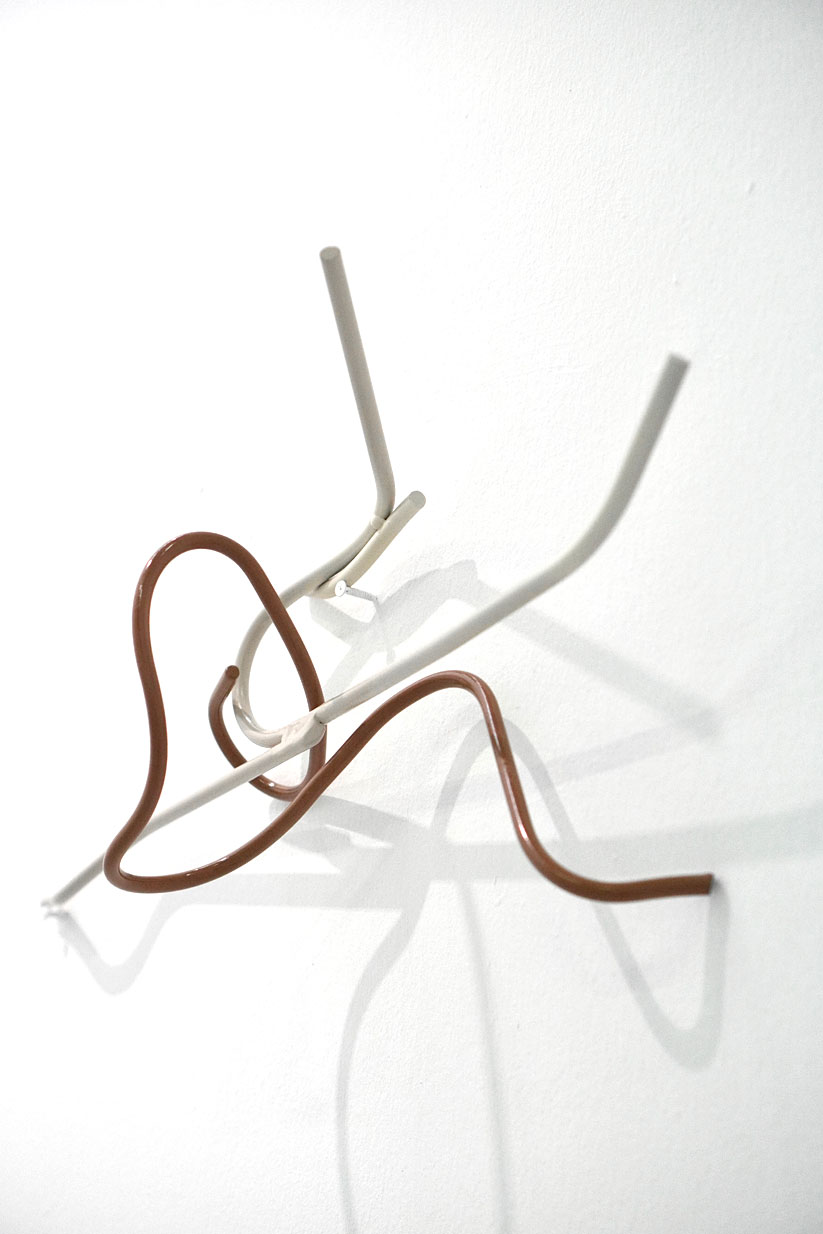
YW: Your working process here begins with a vocabulary list that carries an influence on your artwork and your thoughts. Can you elaborate on how the visuals reflect the verbs?
Aki Hassan: I spend a lot of time sketching. It manifests in the form of drawings and lists of vocabularies, which helps me trace my thoughts and understand what I have been reflecting on. This process is painstakingly repetitive as I constantly recreate what I have penned down until I familiarise myself with the lines, forms and words I created. After multiple exercises of intuitive form and word searching, I sit with these sketches and carefully pick out what I resonate with the most. To me, words embody a sense of physicality and activity, which I rely on as a point of reference for the sculptural exercises I embark on in the workshop. This results in the sculptures and prints I have created for this show.
YW: Can you expand on what you mean by ‘bodily shifts’ in a previous conversation and how your work for this show helps you rethink this concept?
Aki Hassan The word ‘bodily’ has been very vital in my practice. To some extent, it serves as an anchor to the way I relate to everything – be it lines, forms, words and space. In many ways, I have referred to my body as a point of reference, especially in the way I relate to straightness and stiffness, but I feel that the relationship I have with my body is far more nuanced and complex. It does not excite me to regard my body in a literal way, I am not interested in that. My concerns lie in the slightest shifts and adjustments. I pay attention to the pulsing pain of a muscle knot or the awkward stretches over layers of fatness. In this show, I present to you a series of sculptures and prints entitled ‘lingering thoughts, love’. I have been spending a lot of time re-examining the ways in which I exist in this world and the capacities I take up. I take inspiration from the moments I felt hyper-aware of my bodily acts. In this series, I made allowances for forms to echo and bounce off each work, giving them a chance to warp in their own ways.
Filippo Sciascia
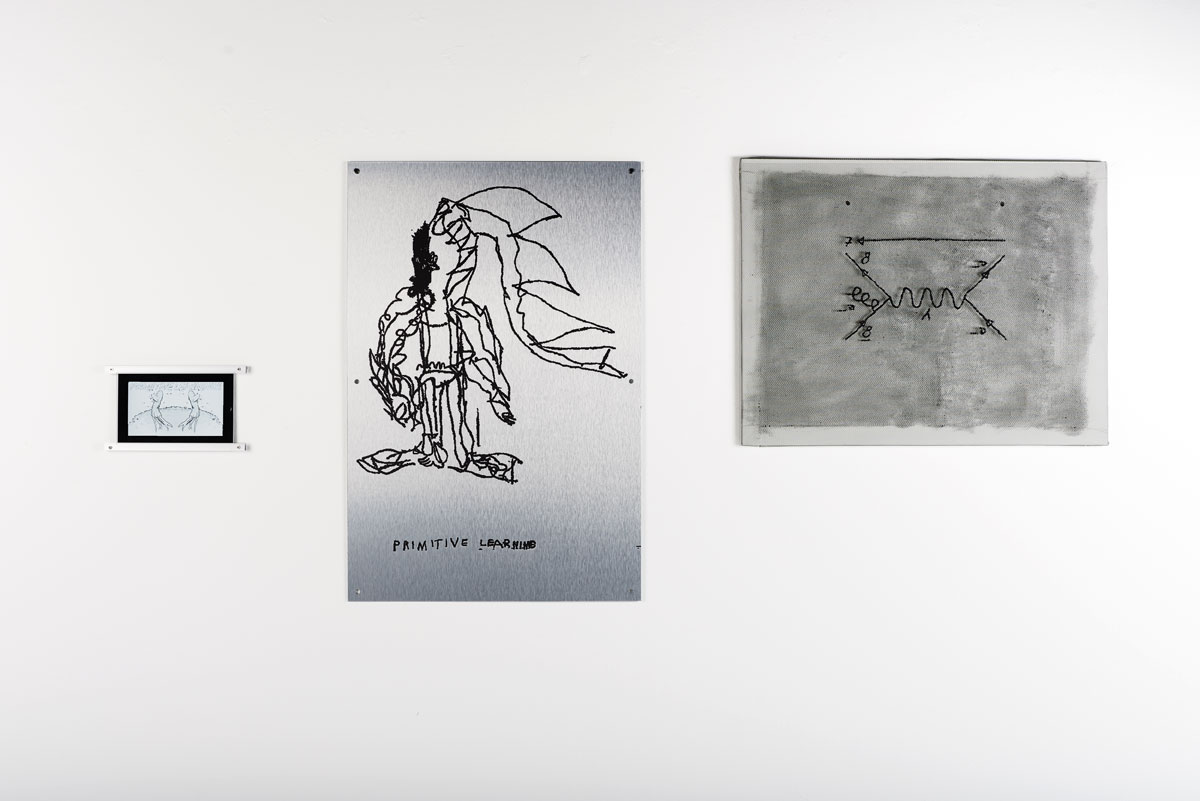
YW: Why did you depict the Feynman Diagram in your latest work?
Filippo Sciascia: Before, mathematical formulae were always described by numbers, but American physicist Richard Feynman was literally scribbling and making patterns – a combination of math and free drawing. I find the “gesturality” of that to be pretty interesting. The Feynman Diagram seemed absurd when it came out. Later, it was awarded the Nobel Prize. Studying and implementing Feynman’s works felt like a meeting from two different points – he was a scientist who went from mathematic to artistic while I went from artistic to mathematic.
YW: Why did you choose to apply the diagram on mesh? Or why did you choose the materials you did for this piece?
Filippo Sciascia: I’m constantly looking for new ways to experiment. I don’t just want to make paintings, although the mesh I used, the way that it’s woven together, is much like the material of a canvas. There are other elements, too. The whole mesh is covered in volcanic sand and the writing itself is glued together by fossilized resin, all coming together to create a geological reference. Everything reconnects to my basic interest in my works about evolution. The word “primitive” refers to primitive things, obviously, but also the evolutionary way that we learn. Nature learns human learns, everything learns. A child’s drawing falls into that category.
YW: Yes, what is behind the decision to blow up your son’s drawing for Primitive Learning?
Filippo Sciascia: I’ve always been interested in how children develop their creativity. Drawing is one of our first instincts, our first language. It was like this when we first started painting cave walls. The act of describing the world with our hands hasn’t changed a bit. So for me, with Primitive Learning, it isn’t so much about the child’s drawing itself as it is about the primitive nature of drawing or representing the world through drawing. I mean, I love my son, but this drawing could have been done by another kid (*laughs*).
YW: What do you mean when you said in 2019: “I did sculpture by doing painting”?
Filippo Sciascia:: The Feynman painting can answer that. It is a “painting” but there is no application of paint, but sculptural materials such as metal and resin. And you might remember in my last show (All We Have at Yeo Workshop), my sculptures were all hanging on the wall like paintings. Two-dimensionality and three-dimensionality are interchangeable to me; I never really differentiate between these two modes of making.
Click here for Filippo Sciascia ‘s Primitive Learning NFT.
Fyerool Darma
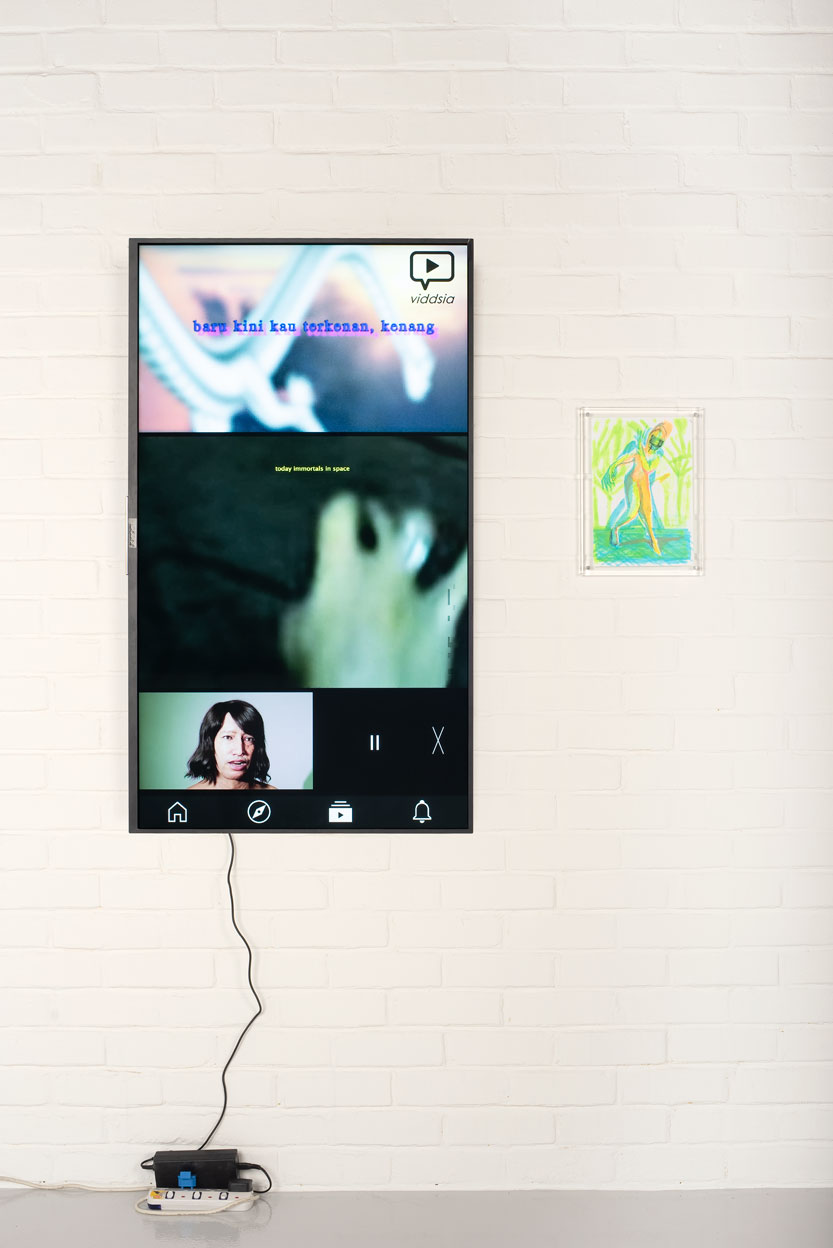
YW: What does ‘Sajak’ mean? What is the most accurate translation in English?
Fyerool Darma: What could be sajak? Or what is sajak? I was thinking of nuances rather than accuracy. These exercises are multiplications of those enquiries. In literary terms, sajak are rhythmic sets of poetry; rap is sajak, song lyrics are sajak, rhythms are sajak, the silence is also sajak and so are ..•~””* * *^~•. What we consider noise is sajak. Would it be sajak to even translate these thoughts in these styles, methods and manners?
YW: What are these new highlighter works on paper? What has led to the recent development of these?
Fyerool Darma: They are storyboards. The highlighters were the cheapest materials I could acquire and I like that it reminds me of the vibrancy of the climate we are in – the eternal summer or scorching heatwave we always get throughout the year. Despite the monsoon wind, there is still a vibrancy to it too.
YW: The ideas in the three series of works (Sajak, recent drawings & pantoum videos) have been prevalent in your practice. What is this “human exercise “ about?
Fyerool Darma: They are exercises in pantun/pantoum, or poetry forms. To locate them, and to consider them as collaborators for a long-term project that I have to aspire to complete. Unlike the literary forms, where oral or texts are known characteristics of its mode of expression, I think the contemporary is also filled with poetics forms beyond that. They are exercises in locating poetry through the present-day lens, be it digital or in real-time. These dualities had always existed within a multiverse. I’m interested in exploring the collision of it within a single screen or when displayed together.
YW: Why have you chosen these particular mediums?
Fyerool Darma: Intuition and the voices I hear tells me to do so. I rely on them more the past months since Circuit Breaker, only to decompress from the overload of information i-r-l and digital.
Jonathan Nichols
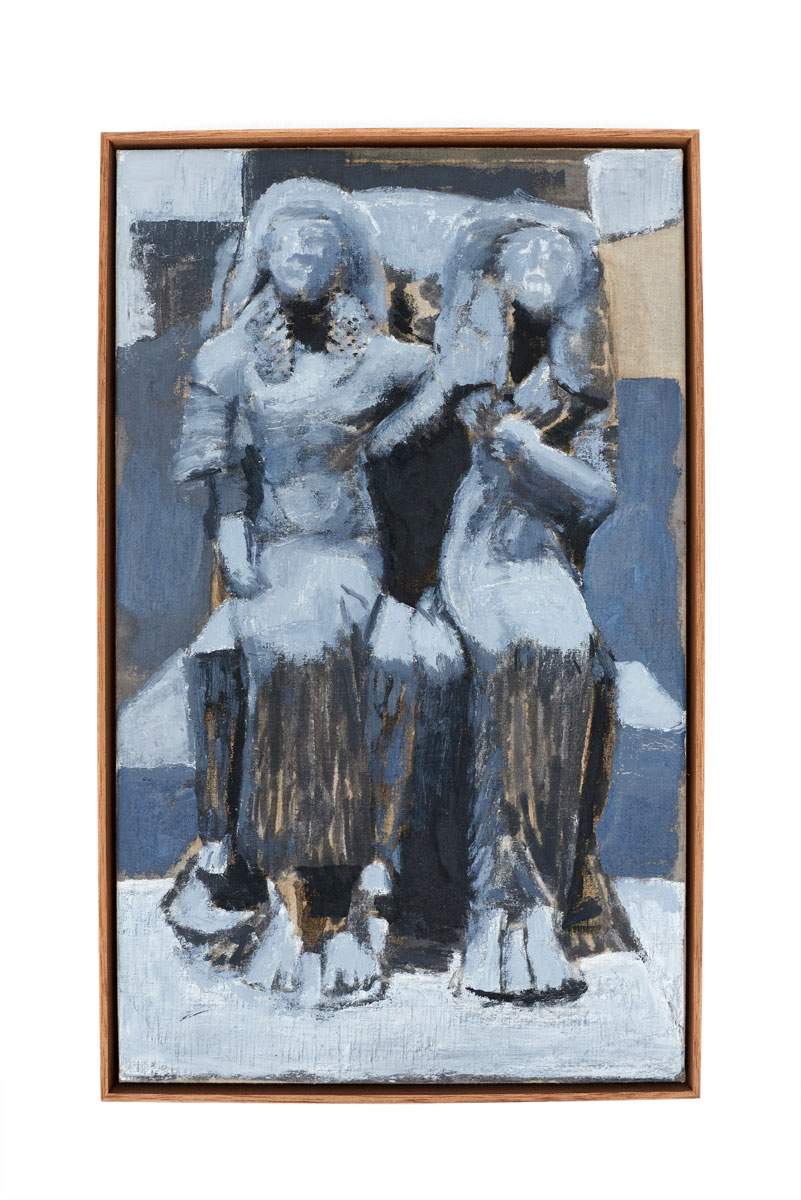
YW: What are your interests since your PHD?
Jonathan Nichols: I continue to use figure motifs and painterly methods similar to the works that you have in Singapore. The paintings unfold from one to the next and in this way, each work is interlinked with the others. I am interested in the idea that paintings are interconnected across time and cultures.
YW: You typically work oil on canvas, but your discovery of Chinese paper at Bras Basah led you on an artistic journey where you proposed painting as a poetic field and act of revivification. Can you share how you continued a painting practice with this medium?
Jonathan Nichols: Paintings are more like people than the inanimate objects they are usually assumed to be. I’m interested in how this works and what we expect paintings to do in the world. When you mention revivification, I think of this in terms of the four works on linen in the exhibition. Each of these paintings began with a pre-existing figure, either from a historical photograph or a statue or religious idol. You might say I’m reviving what could be thought of as dormant. While I was in Singapore I often visited the galleries at the National Gallery dedicated to the work of Wu Guangzhong. Wu’s work was a revelation to me. It was possible to trace his processes very closely from the earlier works to the latter. I was especially interested in his western-style oil painting and I could see these were painted differently from the works on paper. Tracing backwards and forwards across these gave me a kind of way into his work. I felt I could adapt my own practice similarly but reverse the approach by applying my own understanding of painting using the Chinese paper that I was able to source from Guan Yun Zhai’s paper supplies at Bras Basah. There are clearly differences in painterly knowledge between Chinese paper traditions and western oil painting but there are equivalences between them too. In the western tradition, the psychic process itself is the central object of painting but I imagine it’s also a reasonable basis to understand Wu’s work. In my mind, the heightened expectations of one tradition can be turned to accentuate what is possibly dormant in the other. In the studio, I’m continuing to use Chinese paper inspired by the character and painterly methods of Wu Guanzhong.
Xue Mu
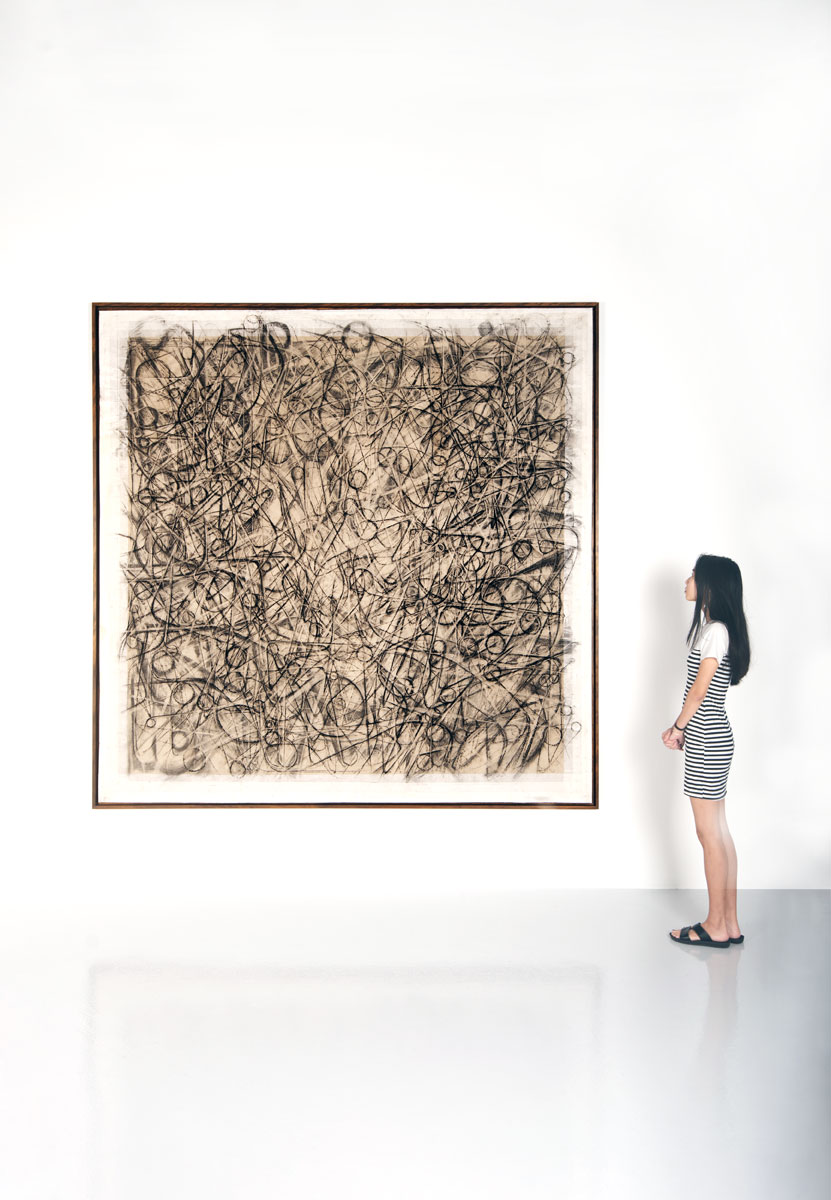
YW: Looking at the sheer size of your latest Black Diamond Drawings, what is the significance of working in this format?
Xue Mu: This size is still within reach of my arms, which means I don’t have to reposition too many times to ensure the continuity of the lines without an electric scaffolding. The surface is only 0.25m2 larger than the Black Diamond drawings I’d typically work on, which is not a significant increase. Nevertheless, the image’s information is surprisingly exponential. This size supports a different image’s character and is more complex and affluent – the expression directs more to an impression of being sublime. Overall, it brings me greater satisfaction and it takes much more time too.
YW: The physical movements can be tracked on this piece – how about your emotional state or energy level? What other factors play a role in this outcome?
Xue Mu: One of the implications I know I am on the right flow is that I’d find myself dancing at a random moment while drawing until reaching my physical limit. Unfortunately, this transcendental joy of activating all the perceptual senses, dancing while “seeing,” and drawing, a complex mechanism of searching and expressing, exceeds the range of spoken language and is impossible to share. Hopefully, this energy would transform into a final image, not a static, two-dimensional picture but a dynamic visual receptacle that retains and releases liveliness. For me, this image somehow communicates with both the archaic (primitive) and the faraway future.
INNATES opens from 15 SEPTEMBER – 7 NOVEMBER 2021 at Yeo Workshop at the Gillman Barracks. Click here for more info.
Click here for Filippo Sciascia ‘s Primitive Learning NFT.
Images and NFT © Yeo Workshop

Artitute
is an online showcase and magazine covering Southeast Asia’s established and emerging visual artists and art scenes.